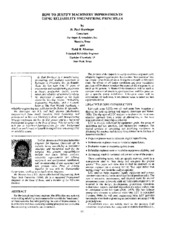| dc.contributor.other | International Pump Users Symposium (16th : 1999) | |
| dc.creator | Barringer, H. Paul | |
| dc.creator | Monroe, Todd R. | |
| dc.date.accessioned | 2017-10-05T16:48:58Z | |
| dc.date.available | 2017-10-05T16:48:58Z | |
| dc.date.issued | 1999 | |
| dc.identifier.uri | https://hdl.handle.net/1969.1/164093 | |
| dc.description | Tutorial | en |
| dc.description | pg. 171 | en |
| dc.description.abstract | For the typical machinery engineer, the difficulties encountered with making reliability improvements lie not with the “mechanics” of improvements, but with justifying the cost of improvements. It is difficult to translate sound engineering principles into terms that the accounting community can understand. The purpose of this paper is to equip machinery engineers with reliability engineering principles that translate “best practices” into net present value financial terms. Using the concepts of life-cycle costs, the effects of off-design conditions and poop installation practices will be shown to reduce the expected life of a pump by as much as 60 percent. A Monte Carlo simulation will be used to compare commercial practices, good practices, and best practices for a specific pump installation. Life-cycle costs will be summarized, for each case, in net present value, to select the best equipment choice. | en |
| dc.format.medium | Electronic | en |
| dc.format.mimetype | application/pdf | |
| dc.language.iso | en | |
| dc.publisher | Texas A&M University. Turbomachinery Laboratories | |
| dc.relation.ispartof | Proceedings of the 16th International Pump Users Symposium | en |
| dc.subject.lcsh | Pumping machinery | en |
| dc.title | How To Justify Machinery Improvements Using Reliability Engineering Principles | en |
| dc.type.genre | Presentation | en |
| dc.type.material | Text | en |
| dc.identifier.doi | https://doi.org/10.21423/R1VQ3D | |


